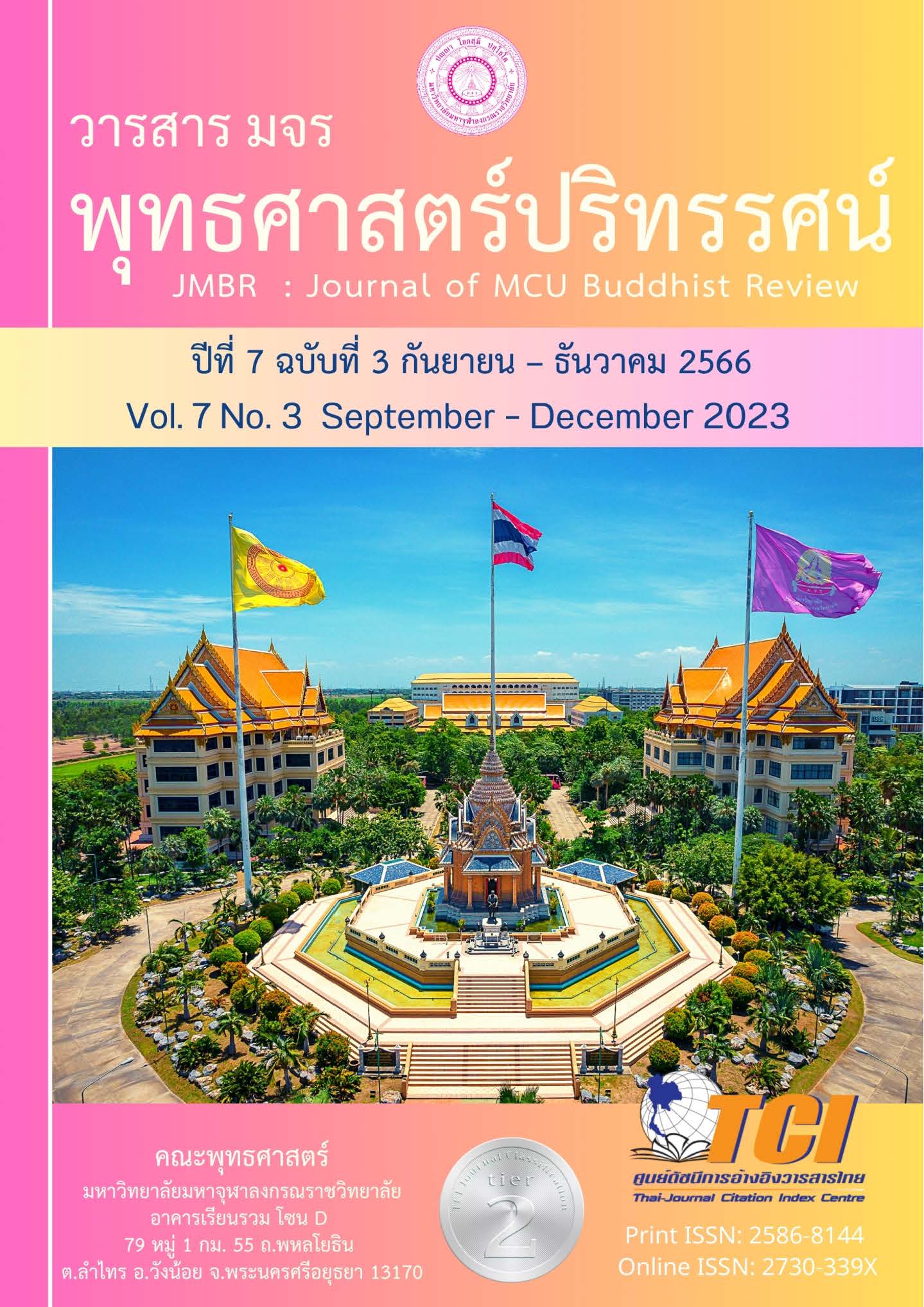ศึกษาวิเคราะห์ฐานสูตรเพื่อนำไปใช้เป็นอุปกรณ์ในการดำเนินชีวิต
Main Article Content
บทคัดย่อ
บทความวิจัยนี้มีวัตถุ 1) เพื่อศึกษาโครงสร้างและสาระสำคัญของฐานสูตร 2) เพื่อศึกษาหลักธรรมในฐานสูตร และ 3) เพื่อวิเคราะห์หลักธรรมในฐานสูตร เป็นงานวิจัยเชิงเอกสาร วิเคราะห์และนำเสนอเชิงพรรณนา
ผลการวิจัยพบว่า 1) ฐานสูตรเป็นพระสูตร เป็นพระสูตรที่แสดงธรรมที่บรรพชิตหรือคฤหัสถ์ควรพิจารณาเนือง ๆ 5 ประการ ได้แก่ ความแก่ ความเจ็บ ความตาย ความพลัดพรากจากสิ่งอันเป็นที่รัก และกรรม 2) หลักธรรมที่ปรากฏในฐานสูตร มี 4 ประการ คือ (1) อัปปมาท ความไม่ประมาท (2) ไตรลักษณ์ ลักษณะ 3 ประการ (3) สติปัฏฐาน ธรรมเป็นที่ตั้งแห่งสติ และ (4) ปฏิจจสมุปบาท ความเกิดขึ้นตั้งอยู่อาศัยกัน 3) การพิจารณาหลักธรรมในฐานสูตรทั้ง 5 ประการโดยความเห็นว่าเป็นธรรมดาเสมอ ย่อมก่อให้เกิดอานิสงส์ 2 ประการ คือ (1) ช่วยพัฒนาตนเองให้บรรลุธรรม การพิจารณาเพื่อความเห็นแจ้งในความสัมพันธ์ซึ่งกันและกันของปรากฏการณ์ต่าง ๆ ทั้งในเรื่องทุกข์ สาเหตุและกำจัดทุกข์ ความปล่อยวางและความว่าง เข้าใจลักษณะที่เป็นกระบวนการของการเกิด - ดับ เกิดสภาวะที่เรียกว่าความหลุดพ้น เข้าถึงจุดมุ่งหมายสูงสุด คือ นิพพาน และ (2) เป็นอุปการคุณในการดำรงชีวิต การพิจารณาให้เห็นถึงสภาวะความเป็นจริงแห่งชีวิตอยู่เสมอ ย่อมได้อานิสงส์ คือ (1) ทำให้เข้าใจชีวิตตามความเป็นจริง (2) เป็นเครื่องเตือนสติให้เราไม่ประมาท และ (3) เป็นเครื่องมือหรืออุปกรณ์ในการสอนตนเองในการดำเนินชีวิต สร้างความเจริญงอกงามในการดำเนินชีวิต หลักธรรมดังกล่าวมีเป้าหมายเพื่อกำจัดและบรรเทาความมัวในวัยหนุ่มสาว ความไม่มีโรคภัยไข้เจ็บในชีวิต ความมัวในความกำหนัด, ความพอใจ, ความรัก, ความชอบ สามารถปรับเปลี่ยนพฤติกรรมคนในระดับปุถุชนให้ประกอบสุจริตทางกาย ทางวาจา และทางใจ ส่วนระดับอริยบุคคล สามารถปฏิบัติเพื่อเข้าถึงมรรคผล นิพพานได้ในที่สุด
Article Details

อนุญาตภายใต้เงื่อนไข Creative Commons Attribution-NonCommercial-NoDerivatives 4.0 International License.
- บทความที่ได้รับการตีพิมพ์เป็นลิขสิทธิ์ของวารสาร มจร พุทธศาสตร์ปริทรรศน์
- ข้อความใดๆ ที่ปรากฎในบทความที่ได้รับการตีพิมพ์ในวารสาร ถือเป็นความรับผิดชอบของผู้เขียนบทความ และข้อคิดเห็นนั้นไม่ถือว่าเป็นทัศนะและความรับผิดชอบของกองบรรณาธิการวารสาร มจร พุทธศาสตร์ปริทรรศน์
เอกสารอ้างอิง
จิตราพันธ์ รักษาขันธ์. (2558). ศึกษาเปรียบเทียบเรื่องตัณหาในพระพุทธศาสนากับคริสต์ศาสนา. วิทยานิพนธ์พุทธศาสตรมหาบัณฑิต บัณฑิตวิทยาลัย: มหาวิทยาลัยมหาจุฬาลงกรณราชวิทยาลัย.
พระครูสุตจินดาภรณ์ (ยงยุทธ ญาณสมฺปนฺโน). (2561). การศึกษาแนวทางการประยุกต์ใช้หลักไตรลักษณ์เพื่อบรรเทาทุกข์ของคนในสังคมปัจจุบัน. วิทยานิพนธ์พุทธศาสตรมหาบัณฑิต บัณฑิตวิทยาลัย: มหาวิทยาลัยมหาจุฬาลงกรณราชวิทยาลัย.
พระเจนฑ์จันทร์ จนฺทปญฺโญ (แสงคำ). (2560). ศึกษาวิเคราะห์วิธีการดับทุกข์ตามแนวทางพระพุทธศาสนาเถรวาท. วิทยานิพนธ์พุทธศาสตรมหาบัณฑิต บัณฑิตวิทยาลัย: มหาวิทยาลัยมหาจุฬาลงกรณราช วิทยาลัย.
พระพรหมคุณาภรณ์ (ป.อ.ปยุตฺโต). (2551). พจนานุกรมพุทธศาสน์ ฉบับประมวลศัพท์ (ชำระ-เพิ่มเติม ช่วงที่ 1). พิมพ์ครั้งที่ 12. กรุงเทพฯ: โรงพิมพ์มหาจุฬาลงกรณราชวิทยาลัย.
พระพรหมคุณาภรณ์ (ป.อ.ปยุตฺโต). (2546). พุทธธรรม. พิมพ์ครั้งที่ 11. กรุงเทพฯ: มหาจุฬาลงกรณราชวิทยาลัย.
พุทธทาสภิกขุ. (2535). คู่มือมนุษย์ฉบับสมบูรณ์. พิมพ์ครั้งที่ 5. กรุงเทพฯ: ธรรมสภาจัดพิมพ์เผยแพร่.
มหาจุฬาลงกรณราชวิทยาลัย. (2539). พระไตรปิฎกภาษาไทย ฉบับมหาจุฬาลงกรณราชวิทยาลัย. กรุงเทพฯ: โรงพิมพ์มหาจุฬาลงกรณราชวิทยาลัย.
มหาจุฬาลงกรณราชวิทยาลัย. (2556). อรรถกถาภาษาไทย ฉบับมหาจุฬาอรรถกถา. กรุงเทพฯ: โรงพิมพ์มหาจุฬาลงกรณราชวิทยาลัย.
แม่ชีภคพร ธรรมญาณี. (2555). ศึกษาแนวทางการใช้หลักอภิณหปัจจเวกขณ์ในการฝึกจิตผู้สูงวัย. วิทยานิพนธ์พุทธศาสตรมหาบัณฑิต บัณฑิตวิทยาลัย: มหาวิทยาลัยมหาจุฬาลงกรณราชวิทยาลัย.


